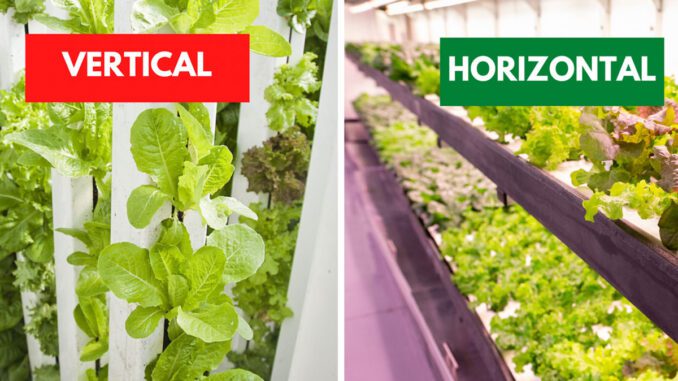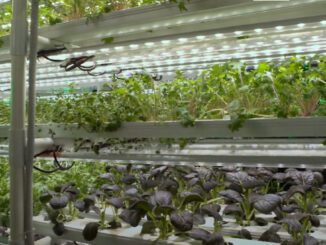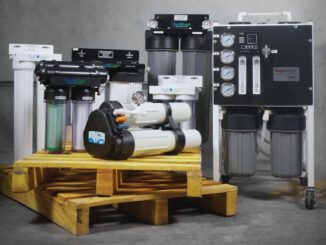
HORIZONTAL VS. VERTICAL STACKING IN HYDROPONIC FARMS
Horizontal VS Vertical Hydroponic Farming | Stephanie Gordon |
You’re picking a modular farm and you notice plants are vertical in one farm and horizontal in another model.
Does this matter?
Will it impact your yields, profitability, or operator experience?
- vertical, hydroponic farm uses hydroponic growing techniques where the plants are stacked on top of each other to grow more with less space.
- Plants can be stacked in horizontal trays or in vertical towers.
- The stacking orientation does not make a big difference, because the type of hydroponic growing system matters more (whether it’s nutrient film technique or deep water culture or ebb and flow).
- In a controlled growing environment, disease pressure is already significantly lower and a horizontal or vertical layout isn’t going to be the deal breaker.
- However, with a vertical layout, gravity is working against the plant and there is a higher possibility of an uneven distribution of light and water along the tower, making for a more stressful growing environment.
Horizontal vs. vertical stacking of plants
First, let’s explain what is meant by horizontal and vertical.
Container or modular farms use hydroponics to grow plants indoors. Hydroponic farming is a method of growing plants in nutrient-rich water, not in soil.
There’s many types of hydroponic farming systems like nutrient film technique (NFT), deep water culture (DWC) and ebb and flow. All these systems deliver nutrient-rich water to the plants in different ways and fit under the umbrella of hydroponic farming.
Some of these systems have a horizontal layout: plants grow how they would grow outdoors, parallel to the ground.
Some of these systems have a vertical layout: plants grow vertically stacked, perpendicular to the ground.
This isn’t to be confused with “vertical farming” – a broader term to describe growing more with less space by stacking plants. Vertical farming can include production methods other than hydroponics, such as aquaponics (involving the use of fish and other aquatic creatures to provide nutrients), aeroponics (growing plants in the air in a misty, humid, environment), and also traditional soil growing.
A vertical, hydroponic farm is a farming system that uses hydroponic growing techniques, and where the plants are stacked on top of each other to grow more with less space.
But they can be stacked in horizontal trays or in vertical towers.
It doesn’t matter because both stacking orientations will still be considered as “vertical farming” because they maximize indoor growing space.
How they’re stacked is what we’ll be talking about in this blog post, horizontal vs. vertical.
Does stacking orientation matter?
In short, not really because the type of hydroponic growing system matters more.
In a controlled growing environment, disease pressure is already significantly lower and a horizontal or vertical layout isn’t going to be the deal breaker.
What does make a difference is whether you’re using nutrient film technique, deep water culture, or ebb and flow to deliver nutrients to your plants. And each hydroponic layout offers its own advantages and disadvantages.

Image: In a deep water culture (DWC) hydroponic system, plants sit rafts with roots submerged in nutrient-rich water.

Image: In a nutrient film technique (NFT) hydroponic system, plants are placed in gutters and a stream of nutrient-rich water flows under the roots.
Considerations for vertical growing
However, growing orientation does make a difference – even if it’s a small one.
In a vertically stacked system (plants grow in towers), gravity is working against the plant. Plants aren’t growing how they want to grow and there is a certain amount of stress.
Ed. Note: Sometimes stress can be beneficial for plant development as part of a management strategy, ie plants grow thicker or sturdier

If you look outside, how do plants grow in nature? Horizontally.
And they bend toward the light.
In a vertical tower, there’s also the possibility of uneven distribution of light and water leaving some plants left in the dark – literally. And the vertical tower is more prone to clogs. There’s greater potential the plants on the edges of your tower – near the top and bottom – will be smaller because they are not getting the same access to light or nutrients as the plants in the middle.
While smaller plants aren’t a bad thing, they could be harder to sell or price competitively.
A horizontally stacked system allows the plants to grow how they’re used to growing in nature with the best odds each plant gets enough nutrients and light.
Conclusion
While there are considerations between how plants are stacked in a modular hydroponic farm, this comparison isn’t the deal breaker. Prioritize comparing other factors such as growing system or structure when picking your modular farm.
Original Article: https://www.thegrowcer.ca/blog/horizontal-vs-vertical-stacking-in-hydroponic-farms



